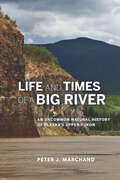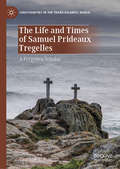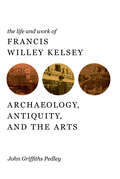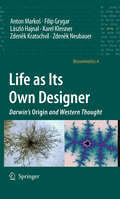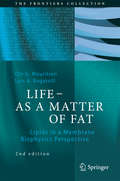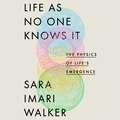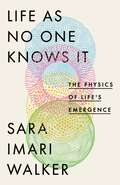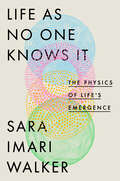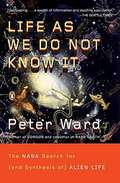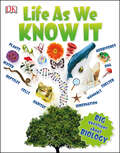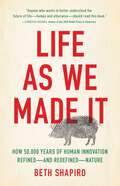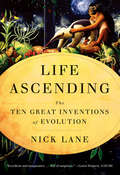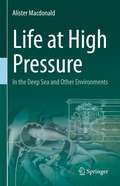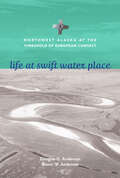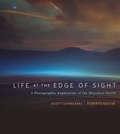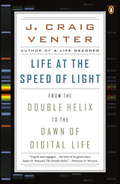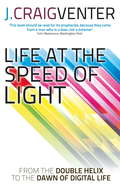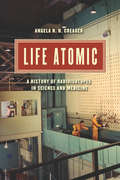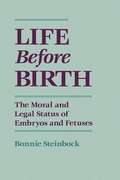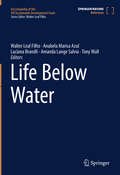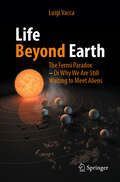- Table View
- List View
Life and Times of a Big River: An Uncommon Natural History of Alaska's Upper Yukon
by Peter J. MarchandWhen Richard Nixon signed the Alaska Native Claims Settlement Act in 1971, eighty million acres were flagged as possible national park land. Field expeditions were tasked with recording what was contained in these vast acres. Under this decree, five men were sent into the sprawling, roadless interior of Alaska, unsure of what they’d encounter and ultimately responsible for the fate of four thousand pristine acres. Life and Times of a Big River follows Peter J. Marchand and his team of biologists as they set out to explore the land that would ultimately become the Yukon-Charley Rivers National Preserve. Their encounters with strange plants, rare insects, and little-known mammals bring to life a land once thought to be static and monotonous. And their struggles to navigate and adapt to an unforgiving environment capture the rigorous demands of remote field work. Weaving in and out of Marchand's narrative is an account of the natural and cultural history of the area as it relates to the expedition and the region’s Native peoples. Life and Times of a Big River chorincles this riveting, one-of-a-kind journey of uncertainty and discovery from a disparate (and at one point desperate) group of biologists.
The Life and Times of Samuel Prideaux Tregelles: A Forgotten Scholar (Christianities in the Trans-Atlantic World)
by Timothy C. StuntThis book sheds light on the career of Samuel Prideaux Tregelles, and in doing so touches on numerous aspects of nineteenth-century British and European religious history. Several recent scholars have celebrated the 200th anniversary of the German textual critic Tischendorf but Tregelles, his contemporary English rival, has been neglected, despite his achievements being comparable. In addition to his decisive contribution to Biblical textual scholarship, this study of Tregelles’ career sheds light on developments among Quakers in the period, and Tregelles’s enthusiastic involvement with the early nineteenth-century Welsh literary renaissance usefully supplements recent studies on Iolo Morganwg. The early career of Tregelles also gives valuable fresh detail to the origins of the Plymouth Brethren, (in both England and Italy) the study of whose early history has become more extensive over the last twenty years. The whole of Tregelles’s career therefore illuminates neglected aspects of Victorian religious life.
The Life and Work of Francis Willey Kelsey: Archaeology, Antiquity, and the Arts
by John Griffiths PedleyPresident of the Archaeological Institute of America, professor at the University of Michigan from 1889 to 1927, and president of the American Philological Association, Francis Kelsey was crucially involved in the founding or growth of major educational institutions. He came to maturity in a period of great technological change in communications, transportation, and manufacturing. Kelsey took full advantage of such innovations in his ceaseless drive to promote education for all, to further the expansion of knowledge, and to champion the benefits of the study of antiquity. A vigorous traveler around the United States, Europe, and the Mediterranean, Kelsey strongly believed in the value of personally viewing sites ancient and modern and collecting artifacts that could be used by the new museums and universities that were springing up in the United States. This collecting habit put him in touch with major financiers of the day, including Charles Freer, Andrew Carnegie, and J. P. Morgan, as he sought their help for important projects. Drawing heavily on Kelsey's daily diaries now held at the University of Michigan's Bentley Historical Library, John Griffiths Pedley gives us a biography that records the wide-ranging activities of a gifted and energetic scholar whose achievements mirrored the creative and contributive innovations of his contemporary Americans.
The Life and Work of Leon Henkin
by María Manzano Ildikó Sain Enrique AlonsoThis is a comprehensive book on the life and works of Leon Henkin (1921-2006), an extraordinary scientist and excellent teacher whose writings became influential right from the beginning of his career with his doctoral thesis on "The completeness of formal systems" under the direction of Alonzo Church. Upon the invitation of Alfred Tarski, Henkin joined the Group in Logic and the Methodology of Science in the Department of Mathematics at the University of California Berkeley in 1953. He stayed with the group until his retirement in 1991. This edited volume includes both foundational material and a logic perspective. Algebraic logic, model theory, type theory, completeness theorems, philosophical and foundational studies are among the topics covered, as well as mathematical education. The work discusses Henkin's intellectual development, his relation to his predecessors and contemporaries and his impact on the recent development of mathematical logic. It offers a valuable reference work for researchers and students in the fields of philosophy, mathematics and computer science.
Life as Its Own Designer
by Zdenek Neubauer László Hajnal Zdenek Kratochvíl Filip Grygar Karel Kleisner Anton MarkošIt has been nearly 150 years since Darwin published On the Origin of Species, and his theory of natural selection still ignites a forest of heated debate between scientific fundamentalists on the one hand and religious fundamentalists on the other. But both sides actually agree more than they disagree, and what has long been needed is a third way to view evolution, one that focuses more on the aspect of life and "being alive", one that can guide us through, and perhaps out of, the fiery thicket. This book, a seminal work in the burgeoning field of Biosemiotics, provides that third way, by viewing living beings as genuine agents designing their communication pathways with, and in, the world. Already hailed as the best account of biological hermeneutics, Life As Its Own Designer: Darwin's Origin and Western Thought is a wholly unique book divided into two parts. The first part is philosophical and explores the roots of rationality and the hermeneutics of the natural world with the overriding goal of discovering how narrative can help us to explain life. It analyzes why novelty is so hard to comprehend in the framework of Western thinking and confronts head-on the chasm between evolutionism and traditional rationalistic worldviews. The second part is scientific. It focuses on the life of living beings, treating them as co-creators of their world in the process of evolution. It draws on insights gleaned from the global activity of the Gaian biosphere, considers likeness as demonstrated on homology studies, and probes the problem of evo-devo science from the angle of life itself. This book is both timely and vital. Past attempts at a third way to view evolution have failed because they were written either by scientists who lacked a philosophical grounding or New Age thinkers who lacked biological credibility. Markoš and his coworkers form an original group of thinkers supremely capable in both fields, and they have fashioned a book that is ideal for researchers and scholars from both the humanities and sciences who are interested in the history and philosophy of biology, biosemiotics, and the evolution of life.
Life - As A Matter Of Fat
by Ole G. Mouritsen Luis A. BagatolliThe present book gives a multi-disciplinary perspective on the physics of life and the particular role played by lipids (fats) and the lipid-bilayer component of cell membranes. The emphasis is on the physical properties of lipid membranes seen as soft and molecularly structured interfaces. By combining and synthesizing insights obtained from a variety of recent studies, an attempt is made to clarify what membrane structure is and how it can be quantitatively described. Furthermore, it is shown how biological function mediated by membranes is controlled by lipid membrane structure and organization on length scales ranging from the size of the individual molecule, across molecular assemblies of proteins and lipid domains in the range of nanometers, to the size of whole cells. Applications of lipids in nanotechnology and biomedicine are also described. The first edition of the present book was published in 2005 when lipidomics was still very much an emerging science and lipids about to be recognized as being as important for life as proteins, sugars, and genes. This significantly expanded and revised edition takes into account the tremendous amount of knowledge gained over the past decade. In addition, the book now includes more tutorial material on the biochemistry of lipids and the principles of lipid self-assembly. The book is aimed at undergraduate students and young research workers within physics, chemistry, biochemistry, molecular biology, nutrition, as well as pharmaceutical and biomedical sciences. From the reviews of the first edition: "This is a highly interesting book and a pleasure to read. It represents a new and excellent pedagogical introduction to the field of lipids and the biophysics of biological membranes. I reckon that physicists and chemists as well as biologists will benefit from this approach to the field and Mouritsen shows a deep insight into the physical chemistry of lipids. " (Göran Lindblom, Chemistry and Physics of Lipids 2005, vol. 135, page 105-106) "The book takes the reader on an exciting journey through the lipid world, and Mouritsen attracts the attention with a lively style of writing . . . . a comprehensive view of the 'lipid sea' can be easily achieved, gaining the right perspectives for envisaging future developments in the nascent field of lipidomics. " (Carla Ferreri, ChemBioChem, Vol. 6 (8), 2005)
Life As No One Knows It: The Physics of Life's Emergence
by Sara Imari WalkerWhat is life? This is among the most difficult open problems in science, right up there with the nature of consciousness and the existence of matter. All the definitions we have fall short. None help us understand how life originates or the full range of possibilities for what life on other planets might look like.In LIFE AS NO ONE KNOWS IT, physicist and astrobiologist Sara Imari Walker argues that solving the origin of life requires radical new thinking and an experimentally testable theory for what life is. This is an urgent issue for efforts to make life from scratch in laboratories here on Earth and missions searching for life on other planets.Walker proposes a new paradigm for understanding what physics encompasses and what we recognize as life. She invites us into a world of maverick scientists working without a map, seeking not just answers but better ways to formulate the biggest questions we have about the universe. The book culminates with the bold proposal of a new theory for identifying and classifying life, one that applies not just to biological life on Earth but to any instance of life in the universe. Rigorous, accessible, and vital, LIFE AS NO ONE KNOWS IT celebrates the mystery of life and the explanatory power of physics.
Life As No One Knows It: The Physics of Life's Emergence
by Sara Imari WalkerWhat is life? This is among the most difficult open problems in science, right up there with the nature of consciousness and the existence of matter. All the definitions we have fall short. None help us understand how life originates or the full range of possibilities for what life on other planets might look like.In LIFE AS NO ONE KNOWS IT, physicist and astrobiologist Sara Imari Walker argues that solving the origin of life requires radical new thinking and an experimentally testable theory for what life is. This is an urgent issue for efforts to make life from scratch in laboratories here on Earth and missions searching for life on other planets.Walker proposes a new paradigm for understanding what physics encompasses and what we recognize as life. She invites us into a world of maverick scientists working without a map, seeking not just answers but better ways to formulate the biggest questions we have about the universe. The book culminates with the bold proposal of a new theory for identifying and classifying life, one that applies not just to biological life on Earth but to any instance of life in the universe. Rigorous, accessible, and vital, LIFE AS NO ONE KNOWS IT celebrates the mystery of life and the explanatory power of physics.
Life as No One Knows It: The Physics of Life's Emergence
by Sara Imari WalkerAn intriguing new scientific theory that explains what life is and how it emerges.What is life? This is among the most difficult open problems in science, right up there with the nature of consciousness and the existence of matter. All the definitions we have fall short. None help us understand how life originates or the full range of possibilities for what life on other planets might look like.In Life as No One Knows It, physicist and astrobiologist Sara Imari Walker argues that solving the origin of life requires radical new thinking and an experimentally testable theory for what life is. This is an urgent issue for efforts to make life from scratch in laboratories here on Earth and missions searching for life on other planets.Walker proposes a new paradigm for understanding what physics encompasses and what we recognize as life. She invites us into a world of maverick scientists working without a map, seeking not just answers but better ways to formulate the biggest questions we have about the universe. The book culminates with the bold proposal of a new theory for identifying and classifying life, one that applies not just to biological life on Earth but to any instance of life in the universe. Rigorous, accessible, and vital, Life as No One Knows It celebrates the mystery of life and the explanatory power of physics.
Life as We Do Not Know It
by Peter WardAn engrossing and revelatory first look at the search for alien life-on Earth and beyond For the past twenty years, Peter Ward has been at the forefront of popular science writing, with books such as the influential and controversial Rare Earth. In Life as We Do Not Know It, Ward, with his signature blend of eloquence, humor, and learned insight, vividly details the latest scientific findings, cutting-edge research, and intrepid new theories on the subject of alien life and the possible extraterrestrial origins of life on Earth. In lucid, entertaining, and bold prose, Peter Ward once again challenges our notions of life on earth (and beyond). .
Life As We Know It (Big Questions)
by DKAs far as we know, Earth is the only inhabited planet in the Universe. So what makes Earth such an ideal place for life to survive? And how did it all get started? Life as We Know It goes back to the beginnings of life on our planet, explaining to middle grade readers how it emerged under hostile conditions from a chemical soup as a simple self-contained unit: the cell. Key biological themes, such as how cells work, produce energy, and reproduce are explained in simple terms. This knowledge is then used to explain how more complex organisms live. The book also looks at the wide variety of plant and animal life on Earth and how it evolved, and introduces the features and characteristics of members of the six kingdoms of life. Young readers will learn how life forms have adapted to occupy particular niches and what can happen if something upsets this balance. Lavishly illustrated with images from DK's extensive natural history photo library, this encyclopedia is a visual feast as well as a thorough treatment of biology. Through DK's unique visual style, scientific ideas that might appear intimidating in a textbook are made lucid at a glance.
Life as We Made It: How 50,000 Years of Human Innovation Refined—and Redefined—Nature
by Beth ShapiroFrom the first dog to the first beefalo, from farming to CRISPR, the human history of remaking nature When the 2020 Nobel Prize was awarded to the inventors of CRISPR, the revolutionary gene-editing tool, it underlined our amazing and apparently novel powers to alter nature. But as biologist Beth Shapiro argues in Life as We Made It, this phenomenon isn&’t new. Humans have been reshaping the world around us for ages, from early dogs to modern bacteria modified to pump out insulin. Indeed, she claims, reshaping nature—resetting the course of evolution, ours and others&’—is the essence of what our species does. In exploring our evolutionary and cultural history, Shapiro finds a course for the future. If we have always been changing nature to help us survive and thrive, then we need to avoid naive arguments about how we might destroy it with our meddling, and instead ask how we can meddle better. Brilliant and insightful, Life as We Made It is an essential book for the decades to come.
Life as We Made It: How 50,000 years of human innovation refined – and redefined – nature
by Beth ShapiroFrom the very first dog to glowing fish and designer pigs – the human history of remaking nature. Virus-free mosquitoes, resurrected dinosaurs, designer humans – such is the power of the science of tomorrow. But this idea that we have only recently begun to manipulate the natural world is false. We&’ve been meddling with nature since the last ice age. It&’s just that we&’re getting better at it – a lot better. Drawing on decades of research, Beth Shapiro reveals the surprisingly long history of human intervention in evolution through hunting, domesticating, polluting, hybridizing, conserving and genetically modifying life on Earth. Looking ahead to the future, she casts aside the scaremongering myths on the dangers of interference, and outlines the true risks and incredible opportunities that new biotechnologies will offer us in the years ahead. Not only do they present us with the chance to improve our own lives, but they increase the likelihood that we will continue to live in a rich and biologically diverse world.
Life Ascending: The Ten Great Inventions of Evolution
by Nick Lane"Original and awe-inspiring . . . an exhilarating tour of some of the most profound and important ideas in biology."--New Scientist Where does DNA come from? What is consciousness? How did the eye evolve? Drawing on a treasure trove of new scientific knowledge, Nick Lane expertly reconstructs evolution's history by describing its ten greatest inventions--from sex and warmth to death--resulting in a stunning account of nature's ingenuity.
Life at High Pressure: In the Deep Sea and Other Environments
by Alister MacdonaldThe book discusses the ways in which high hydrostatic pressure (i.e. water pressure) affects all grades of life which thrive at pressures much greater those in our normal environment. The deep sea is the best known high pressure environment, where pressures reach a thousand times greater than those at the surface, yet it is populated by a variety of animals and microorganisms. The earth’s crust supports microorganisms which live in water filled pores at high pressure. In addition, the load bearing joints of animals like ourselves experience pulses of hydrostatic pressure of a magnitude similar to the pressure at mid ocean depths.These pressures affect molecular structures and biochemical reactions. Basic cellular processes are drastically affected – the growth and division of cells, the way nerves conduct impulses and the chemical reactions which provide energy. Adaptation to high pressure also occurs in complex physiological systems such as those which provide buoyancy. Probably the greatest challenge to our understanding of adaptation to high pressure is the stabilisation of the nervous system of deep sea animals to avoid convulsions which pressure causes in shallow water animals. Additionally the book provides insight into the engineering required to study life at high pressure: equipment which can trap small deep sea animals and retrieve them at their high pressure, equivalent equipment for microorganisms, laboratory microscopes which can focus on living cells under high pressure, incubators for bacteria which require high pressure to grow, high pressure aquaria for marine animals and lastly and briefly, manned and unmanned submersible vessels, Landers and deep drill hole sampling. Rather like the organisms studied many laboratory instruments have been adapted to function at high pressure.
Life at Swift Water Place: Northwest Alaska at the Threshold of European Contact
by Anderson, Douglas D.; Anderson, Wanni W.This is a multidisciplinary study of the early contact period of Alaskan Native history that follows a major hunting and fishing Inupiaq group at a time of momentous change in their lifeways. The Amilgaqtau yaagmiut were the most powerful group in the Kobuk River area. But their status was forever transformed thanks to two major factors. They faced a food shortage prompted by the decline in caribou, one of their major foods. This was also the time when European and Asian trade items were first introduced into their traditional society. The first trade items to arrive, a decade ahead of the Europeans themselves, were glass beads and pieces of metal that the Inupiat expertly incorporated into their traditional implements. This book integrates ethnohistoric, bio-anthropological, archaeological, and oral historical analyses.
Life at the Edge of Sight: A Photographic Exploration of the Microbial World
by Scott Chimileski Roberto Kolter Moselio SchaechterThis stunning photographic essay opens a new frontier for readers to explore through words and images. Microbial studies have clarified life’s origins on Earth, explained the functioning of ecosystems, and improved both crop yields and human health. Scott Chimileski and Roberto Kolter are expert guides to an invisible world waiting in plain sight.
Life at the Extremes: The Science of Survival
by Frances AshcroftThe challenge of scaling the highest mountain, exploring the deepest ocean, crossing the hottest desert, or swimming in near-freezing water is irresistible to many people. Life at the Extremes is an engrossing exploration of what happens to our bodies in these seemingly uninhabitable environments. Frances Ashcroft weaves stories of extraordinary feats of endurance with historical material and the latest scientific findings as she investigates the limits of human survival and the remarkable adaptations that enable us to withstand extreme conditions. What causes mountain sickness? How is it possible to reach the top of Everest without supplementary oxygen, when passengers in an airplane that depressurized at the same altitude would lose consciousness in seconds? Why do divers get the bends but sperm whales do not? How long you can survive immersion in freezing water? Why don't penguins get frostbite? Will men always be faster runners than women? How far into deep space can a body travel?
Life at the Speed of Light
by J. Craig VenterThe renowned scientist and author of A Life Decoded examines the creation of life in the new field of synthetic genomics.
Life at the Speed of Light: From the Double Helix to the Dawn of Digital Life
by J. Craig VenterIn 2010, scientists led by J. Craig Venter became the first to successfully create 'synthetic life' -- putting humankind at the threshold of the most important and exciting phase of biological research, one that will enable us to actually write the genetic code for designing new species to help us adapt and evolve for long-term survival. The science of synthetic genomics will have a profound impact on human existence, including chemical and energy generation, health, clean water and food production, environmental control, and possibly even our evolution.In Life at the Speed of Light, Venter presents a fascinating and authoritative study of this emerging field from the inside -- detailing its origins, current challenges and controversies, and projected effects on our lives. This scientific frontier provides an opportunity to ponder anew the age-old question 'What is life?' and examine what we really mean by 'playing God'. Life at the Speed of Light is a landmark work, written by a visionary at the dawn of a new era of biological engineering.
Life Atomic: A History of Radioisotopes in Science and Medicine (Synthesis Ser.)
by Angela N. CreagerAfter World War II, the US Atomic Energy Commission (AEC) began mass-producing radioisotopes, sending out nearly 64,000 shipments of radioactive materials to scientists and physicians by 1955. Even as the atomic bomb became the focus of Cold War anxiety, radioisotopes represented the government’s efforts to harness the power of the atom for peace—advancing medicine, domestic energy, and foreign relations. In Life Atomic, Angela N. H. Creager tells the story of how these radioisotopes, which were simultaneously scientific tools and political icons, transformed biomedicine and ecology. Government-produced radioisotopes provided physicians with new tools for diagnosis and therapy, specifically cancer therapy, and enabled biologists to trace molecular transformations. Yet the government’s attempt to present radioisotopes as marvelous dividends of the atomic age was undercut in the 1950s by the fallout debates, as scientists and citizens recognized the hazards of low-level radiation. Creager reveals that growing consciousness of the danger of radioactivity did not reduce the demand for radioisotopes at hospitals and laboratories, but it did change their popular representation from a therapeutic agent to an environmental poison. She then demonstrates how, by the late twentieth century, public fear of radioactivity overshadowed any appreciation of the positive consequences of the AEC’s provision of radioisotopes for research and medicine.
Life Before Birth: The Moral and Legal Status of Embryos and Fetuses (2nd Edition)
by Bonnie SteinbockThis book provides a framework for thinking clearly and coherently about the unborn. The book's thesis, the "interest view," states that all and only beings who have interests have moral standing, and only beings who possess conscious awareness have interests. The chapters apply the interest view, and explore the moral and legal aspects of a wide range of issues.
Life Below Water (Encyclopedia of the UN Sustainable Development Goals)
by Walter Leal Filho Anabela Marisa Azul Luciana Brandli Amanda Lange Salvia Tony WallThe problems related to the process of industrialisation such as biodiversity depletion, climate change and a worsening of health and living conditions, especially but not only in developing countries, intensify. Therefore, there is an increasing need to search for integrated solutions to make development more sustainable. The United Nations has acknowledged the problem and approved the “2030 Agenda for Sustainable Development”. On 1st January 2016, the 17 Sustainable Development Goals (SDGs) of the Agenda officially came into force. These goals cover the three dimensions of sustainable development: economic growth, social inclusion and environmental protection. The Encyclopedia of the UN Sustainable Development Goals comprehensively addresses the SDGs in an integrated way. It encompasses 17 volumes, each one devoted to one of the 17 SDGs. This volume is dedicated to SDG 14 “Conserve and sustainably use the oceans, seas and marine resources for sustainable development". Marine and coastal bio-resources, play an essential role in human well-being and social and economic development. This volume addresses this sustainability challenge providing the description of a range of terms, which allows a better understanding and fosters knowledge about it.Concretely, the defined targets are:Prevent and significantly reduce marine pollution of all kinds, in particular from land-based activities, including marine debris and nutrient pollutionSustainably manage and protect marine and coastal ecosystems to avoid significant adverse impacts, including by strengthening their resilience, and take action for their restoration in order to achieve healthy and productive oceansMinimize and address the impacts of ocean acidification, including through enhanced scientific cooperation at all levelsEffectively regulate harvesting and end overfishing, illegal, unreported and unregulated fishing and destructive fishing practices and implement science-based management plans, in order to restore fish stocks in the shortest time feasible, at least to levels that can produce maximum sustainable yield as determined by their biological characteristicsConserve at least 10 per cent of coastal and marine areas, consistent with national and international law and based on the best available scientific informationProhibit certain forms of fisheries subsidies which contribute to overcapacity and overfishing, eliminate subsidies that contribute to illegal, unreported and unregulated fishing and refrain from introducing new such subsidies, recognizing that appropriate and effective special and differential treatment for developing and least developed countries should be an integral part of the World Trade Organization fisheries subsidies negotiation 16Increase the economic benefits to small island developing states and least developed countries from the sustainable use of marine resources, including through sustainable management of fisheries, aquaculture and tourism Increase scientific knowledge, develop research capacity and transfer marine technology, taking into account the Intergovernmental Oceanographic Commission Criteria and Guidelines on the Transfer of Marine Technology, in order to improve ocean health and to enhance the contribution of marine biodiversity to the development of developing countries, in particular small island developing states and least developed countriesProvide access for small-scale artisanal fishers to marine resources and marketsEnhance the conservation and sustainable use of oceans and their resources by implementing international law as reflected in the United Nations Convention on the Law of the Sea, which provides the legal framework for the conservation and sustainable use of oceans and their resources, as recalled in paragraph 158 of “The future we want”Editorial Board</di
Life Beyond Earth
by Athena Coustenis Thérèse EncrenazWhat is life and where can it exist? What searches are being made to identify conditions for life on other worlds? If extraterrestrial inhabited worlds are found, how can we explore them? In this book, two leading astrophysicists provide an engaging account of where we stand in our quest for habitable environments, in the Solar System and beyond. Starting from basic concepts, the narrative builds scientifically, including more in-depth material as boxed additions to the main text. The authors recount fascinating recent discoveries from space missions and observations using ground-based telescopes, of possible life-related artefacts in Martian meteorites, extrasolar planets, and subsurface oceans on Europa, Titan and Enceladus. They also provide a forward look to future missions. This is an exciting, informative read for anyone interested in the search for habitable and inhabited planets, and an excellent primer for students in astrobiology, habitability, planetary science and astronomy.
Life Beyond Earth: The Fermi Paradox -- Or Why We Are Still Waiting to Meet Aliens
by Luigi VaccaThis book analyzes the likelihood of intelligent civilizations from two different standpoints: firstly, using the famous Drake equation and, secondly, by analyzing some of the most popular hypotheses about the likely behavior of intelligent alien civilizations. The existence of intelligent extraterrestrial civilizations in the universe is one of the most intriguing scientific and philosophical problems. Is it possible that we are the only intelligent species in this incredibly vast universe? Enrico Fermi, one of the greatest physicists of the 20th century, posed the same question during a lunch with his colleagues in 1950. What are the implications for a universe where there is only one intelligent species? The universe may be stranger than we think.
